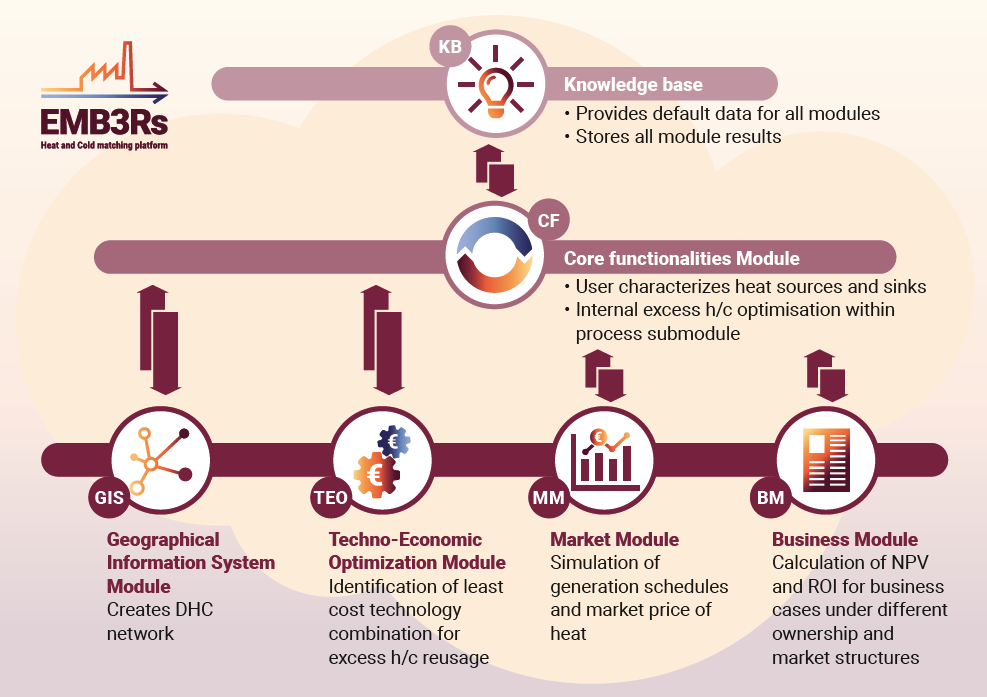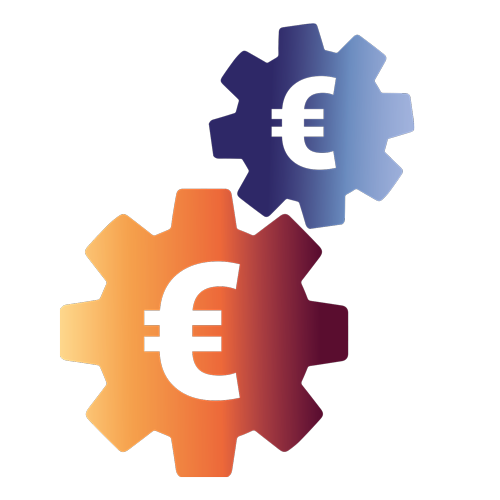Platform
For developers – Would you like to contribute?
You are welcome to contribute via the open GitHub project of the Platform. There, you will find, among others, instructions on how to contribute.
If you would like to report bugs or suggestions for improvements / new features, please open new ‘Issues’ or make ‘pull requests’ on the relevant repositories.
For users – Would you like to learn more or are you experiencing problems using the platform?
You may find your answers already in the descriptions and documentation of the modules on this website and the GitHub repositories.
Training material can be found here.
If you have more questions, you’re welcome to visit the Q&A forum of EMB3RS, to scan through existing questions or post new ones.
For other queries you may contact us at emb3rs.team@pdmfc.com
Modules
The EMB3Rs platform has been designed to evaluate the reuse and trade of waste Heating and Cooling (HC) in a holistic perspective within an industrial process, energy system environment, or in District Heating and Cooling (DHC) systems under-regulated and liberalized market environment. The platform empowers industrial users and stakeholders to investigate the economic potential of their investment in the recovery of waste HC as an energy resource, based on the simulation of supply-demand scenarios. To this end, the platform is able to simulate multiple business and market models for DHC systems. The EMB3Rs platform is composed of five modules:
The purpose of the Core Functionalities Module is to provide a comprehensive quantification of the energy flows of the EMB3RS platform objects (sinks, sources, and links) and costs associated with different options for excess H/C recovery and use. This information is used by the other analysis modules (GIS, TEO, MM and BM) to perform simulations according to user specifications. The CF module has two main functionalities:
- Full characterization of objects – e.g., in terms of processes, equipment, building characteristics
- To carry out a preliminary analysis of available supply and demand – described as a simulation feature within the CF.
For more info please click on the icon on the left.
The purpose of the Geographical Information System Module within EMB3Rs is to analyse possible network solutions for a given set of sources and sinks as well as an assumption of related network heat/cold losses and costs. The GIS thereby finds such a network solution along the existing Open Street Map (OSM) Road Network connecting all sources and sinks. It currently outputs a graph/map that lets the user check the specifications of every single pipe element from the network found and a table that illustrates all source/sink specific losses, costs, network length and installed pipe capacity.
For more info please click on the icon on the left.
The Techno-Economic Optimization Module identifies least-cost combinations of technologies for using and conveying excess heating or cooling (HC) from defined sources to defined sinks. The user (representing the excess heat producer – i.e., source – or a demand point – i.e., sink) wants to evaluate the least-cost options of utilising excess HC generated to meet the heating/cooling demand for one or more known/assumed sinks. The objective of the optimisation is to find the least-cost mix of technologies (in terms of installed capacities – typically, in power units) and match between sources and sinks (in terms of energy flows) that satisfies the demands under constraints dictated by regulation, availability of heat, load profiles, techno-economic characteristics of technologies, investment plans.
For more info please click on the icon on the left.
The Market Module will provide the user with economic and fairness indicators like energy transaction, market price, social welfare, fairness among prices. This will be done by short-term and long-term market analyses that simulate various market structures and incorporate business conditions and network models. The MM will consider the existing Pool market as well as new forms of a decentralized market based on peer-to-peer and community systems. The modelling of heat/cold sources and sinks will include flexibility, offering price and business preferences.
For more info please click on the icon on the left.
The Business Model Module evaluates various business models for DHC which incorporates excess heat. This is done by calculating matrices like Net Present Value (NPV), Levelized Cost of Heat (LCOH) and Internal Rate of Return (IRR) under different ownership structures and market frameworks.
For more info please click on the icon on the left.





